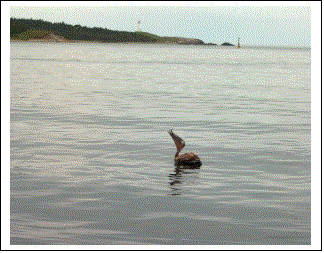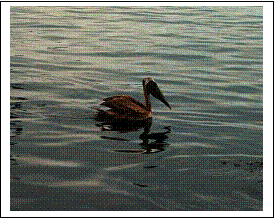Partners
Website Design and Content
© by Eric Krause, Krause House
Info-Research Solutions (© 1996)
All Images © Parks
Canada Unless Otherwise Designated
Researching the
Fortress of Louisbourg National Historic Site of Canada
Recherche sur la Forteresse-de-Louisbourg Lieu historique national du Canada
FOR THE BIRDS
SEPTEMBER
2003
By
Helen
O'Shea
SIGHTINGS
-
Don and Margie Cameron reported 2 Gray Jays and
a White-crowned Sparrow.
-
Bill O’Shea saw 2 Loons at French Village
Lake on June 9.
-
Cyneth Hutt called June 12 to report a pair of
Ruby-throated Hummingbirds, House Sparrows, Song Sparrows and Blue Jays.
On May 26 she had seen a male Baltimore Oriole.
-
Bonnie Dalziel had seen a male Yellow Warbler
and a Dickcissel on June 11.
-
Bill O’Shea reported the Rara Avis, a tall
ship, at the wharf on June 13. He
saw a male Northern Harrier on Route 22 and a pair of Northern Flickers
on Father’s Day.
-
Linda Burke reported a Northern Flicker on our
lawn on June 16.
-
Rosie Lahey reported lots of Grackles and Crows
on June 30. Her Ruby-throated
Hummingbirds had been gone for several weeks.
She saw 4 eggs and a nest on a bait barrel earlier that month.
-
Gisele Gartland reported Catbirds nesting in
the trees in their yard. Paul had
also noticed a Semi-palmated Plover along the shore.
-
Clarence “Soups” Perry mentioned on July 29
that he had had the Brown Pelican on his boat off Baleine, tried to feed it, but
it wouldn’t eat the fish.
-
Albert Bussey had the Brown Pelican off the
Lighthouse before that.
-
Carol Corbin’s cat killed a Song Sparrow on
July 29. Cats are like that.
-
Mary Kay MacKinnon was trying to assist a young
Robin that had fallen from a nest.
-
Gary Peck saw a Bald Eagle catch a fish in
Catalone Lake on August 3. This was
the first time he had seen an eagle succeed. Even though there are 2 eagle nests in the area, he has seen
no offspring this summer.
-
Elaine Carter reported that a Ruby-throated
Hummingbird had been back at their feeders for more than a week on August 13.
She later watched it bring a little one to her feeder throughout the day
by August 21.
AROUND THE
TOWN
By mid-July adult Crows were seen
feeding their young on various lawns through the town.
There was almost no difference in size although the begging behaviour
identified the young. Very few
Great Blue Herons were seen in the local area this year although most were seen
flying overhead. Several were at
the Fortress, Route 22, over the Administration road up near the water tower.
The young European Starlings were everywhere.
They are the brown birds that look like their black parents and are
congregating in trees and on fences and chimneys.
A female Downy Woodpecker was in my backyard on August 18.
A Rock Dove (pigeon) was on the lawn of Chris and Darlene Chisholm on
August 20. This was the first
sighting in the neighbourhood. Usually
there are Mourning Doves only.
AROUND THE
HARBOUR
Throughout late July and the month of
August there were Whimbrels seen at the Fortress site ranging from 3 in the bog
to 23 flying overhead. It was a
banner year for Cormorants in late summer although they seemed off to a slow
start. There were a few Barn and
Cliff Swallows hawking at the Fortress in early September.
RARE
BIRD
 The
afternoon of July 1 Cathy and Donald MacLeod reported a Pelican on Robert
Levy’s Wharf. Bill and I searched
in vain for the bird. Doug Pearl
called to report a Pelican off the point of Louisbourg Harbour and said it was
around for a couple of days. Gerry
Gartland reported the Pelican downtown along the waterfront where it was sighted
by numerous individuals on July 3. Leo Carter said he had thrown pieces of bait (mackerel) to
the Brown Pelican and it was happy to eat them.
On July 11 Carlo Lunn emailed me a couple of photos of the Pelican.
The
afternoon of July 1 Cathy and Donald MacLeod reported a Pelican on Robert
Levy’s Wharf. Bill and I searched
in vain for the bird. Doug Pearl
called to report a Pelican off the point of Louisbourg Harbour and said it was
around for a couple of days. Gerry
Gartland reported the Pelican downtown along the waterfront where it was sighted
by numerous individuals on July 3. Leo Carter said he had thrown pieces of bait (mackerel) to
the Brown Pelican and it was happy to eat them.
On July 11 Carlo Lunn emailed me a couple of photos of the Pelican.
I’ve reproduced Carlo’s pictures
here in black and white, but for those who have access
to the web the photos can be seen in colour at the following address: HO’Shea.html
The first recorded sighting of a Brown
Pelican in Louisbourg was almost 100 years ago. The Sydney Record on May
25, 1904 reported that, “ For some days last week two large and peculiar birds
were seen hovering about West Louisbourg. Mr. John Kelly on Thursday shot one of
them. From the peculiar appearance of the bird no one about this place knew what
species it belonged to. Mr. Laurence Bates, express agent of the S&L
Railway, took it to Sydney to have it sent to the museum at Halifax. It appears
that it was a brown pelican a bird entirely foreign to these latitudes. It
measures seven and a half feet from the tip of one wing to the tip of the other
and had under its throat a large sack for the carrying of its food. It is said
Mr. Kelly received $13 for the bird.”
 Robie
Tufts writes that “The Brown Pelican is a rare vagrant in Nova Scotia.
A male was taken at Louisbourg on 4 May 1904 and is now in the Nova
Scotia Museum. This pelican breeds in the Caribbean and Atlantic coasts from
Georgia to Brazil; and in the Pacific from Washington State to Ecuador.
Its manner of fishing is spectacular and quite different from that of its
larger cousin, the White Pelican. It
dives headlong for its food from an altitude of 30 m or more, like the Gannet.
Almost all the Nova Scotia occurrences were within May and June.”
Birds of Nova Scotia,
3rd Edition, 1986.
Robie
Tufts writes that “The Brown Pelican is a rare vagrant in Nova Scotia.
A male was taken at Louisbourg on 4 May 1904 and is now in the Nova
Scotia Museum. This pelican breeds in the Caribbean and Atlantic coasts from
Georgia to Brazil; and in the Pacific from Washington State to Ecuador.
Its manner of fishing is spectacular and quite different from that of its
larger cousin, the White Pelican. It
dives headlong for its food from an altitude of 30 m or more, like the Gannet.
Almost all the Nova Scotia occurrences were within May and June.”
Birds of Nova Scotia,
3rd Edition, 1986.
As luck would have it, Bill and I flew out on
July 2 to a family reunion in Cornwall, Ontario and missed the rare opportunity
of observing this bird.
Helen O’Shea
Extracted from © The
Seagull, Helen O'Shea, For the Birds
Return to the Previous page

Retour à la page précédente
 The
afternoon of July 1 Cathy and Donald MacLeod reported a Pelican on Robert
Levy’s Wharf. Bill and I searched
in vain for the bird. Doug Pearl
called to report a Pelican off the point of Louisbourg Harbour and said it was
around for a couple of days. Gerry
Gartland reported the Pelican downtown along the waterfront where it was sighted
by numerous individuals on July 3. Leo Carter said he had thrown pieces of bait (mackerel) to
the Brown Pelican and it was happy to eat them.
On July 11 Carlo Lunn emailed me a couple of photos of the Pelican.
The
afternoon of July 1 Cathy and Donald MacLeod reported a Pelican on Robert
Levy’s Wharf. Bill and I searched
in vain for the bird. Doug Pearl
called to report a Pelican off the point of Louisbourg Harbour and said it was
around for a couple of days. Gerry
Gartland reported the Pelican downtown along the waterfront where it was sighted
by numerous individuals on July 3. Leo Carter said he had thrown pieces of bait (mackerel) to
the Brown Pelican and it was happy to eat them.
On July 11 Carlo Lunn emailed me a couple of photos of the Pelican. 